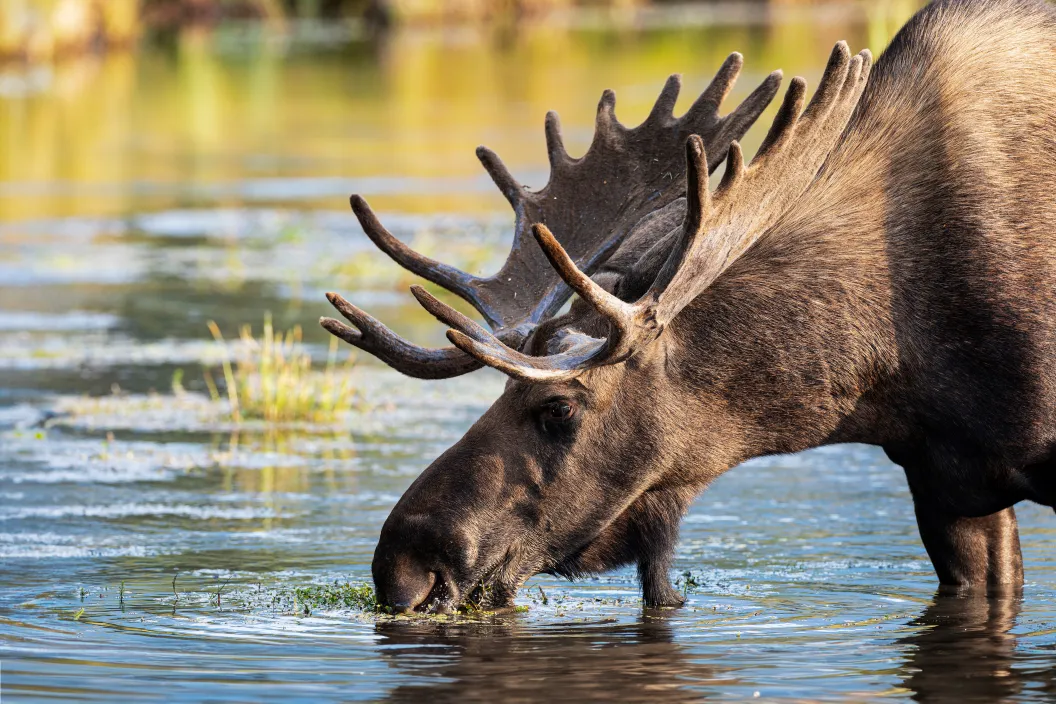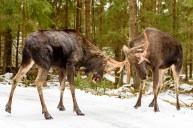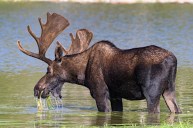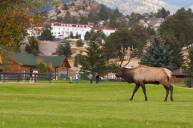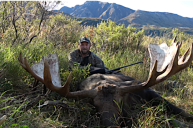When anyone gives consideration to North America's largest wild creatures, it's only natural to wonder what animal ranks as the largest. For those of us who hunt, their minds go straight to members of the deer family, and one deer family member in particular: the moose, or alces alces by its scientific name.
In a competition for the largest North American land animal, the moose is the clear-cut winner. But how big is a moose, really? As the largest member of the deer family, (which also includes different deer species like elk and caribou) a full-grown bull moose is probably even bigger than you think it is. Bull moose (the term for an adult male moose) in Alaska and the Yukon can weigh between 1,200 and 1,650 pounds, with bodies up to 10 feet long and standing 6 to 7 feet at the shoulder. Add on the head, with the dewlap, or bell, hanging from their chin, and those massive moose antlers and you have yourself an absolute monster of an animal that truly demands respect.
It's hard to imagine an animal like this still exists in the world, particularly in North America. Moose seem almost like a relic from our past that would've been rubbing shoulders with the now-extinct wooly mammoth and running from cavemen on the hunt. And yet, they're still found across northern North America, from Maine to Alaska to Canada, as well as in the forests of Europe.
While moose populations are thriving in places like Alaska and the Yukon, populations are in decline in certain parts of the United States, like Minnesota and the Northeast. Studies are still hoping to determine the cause of the decline, but the most likely culprits include a loss of moose habitat, tick-borne diseases, brain worms, bacterial infections, liver flukes, and climate change.
But for now, when it comes to how big a full-grown moose really is, let's have some fun. Today we're going to dive in and take a closer look at how big moose actually are, and what factors can cause that size to vary.
How much does a moose weigh?
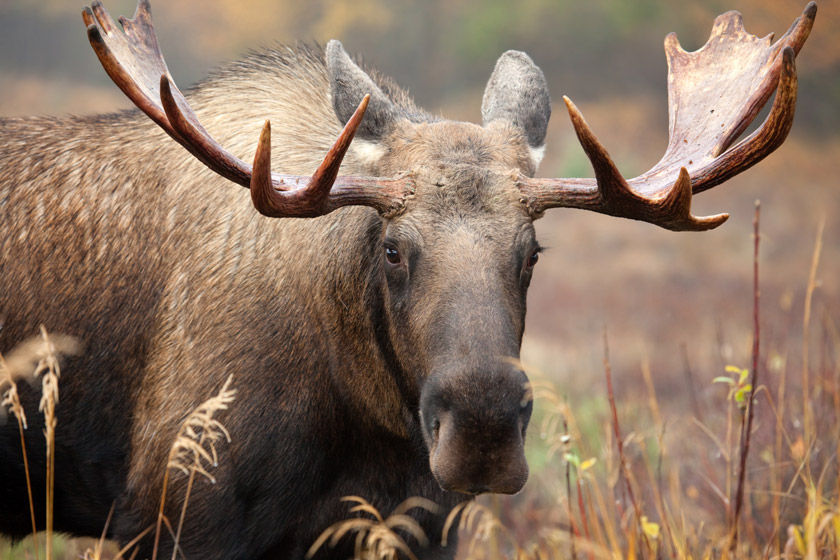
As mentioned, moose can weigh well over 1,000 pounds. Just to put that in perspective, that's roughly the same weight as a grand piano. Moose size varies between the different subspecies, as well as between bull moose and female moose. North America has four different subspecies of moose.
- The Alaska, or Alaskan Moose (alces alces gigas): in Alaska and Western Yukon
- The Western Moose (alces alces andersoni): in British Columbia, Ontario, Michigan, Wisconsin, and Minnesota.
- The Eastern Moose (alces alces Americana): in eastern Canada and the northeastern United States, mostly New England
- The Shiras Moose (alces alces shirasi): in Wyoming, Idaho, Utah, Colorado, Washington, Oregon, and Montana
There are also two other species of moose; the Eurasian moose, found in northern Europe and Asia, and the Siberian moose, found in the sub-arctic and arctic regions of Russia.
The Alaska moose is the largest of the subspecies, weighing up to 1,600 pounds. Even a small adult female moose typically weighs over 800 pounds. The Shiras moose are the smallest of the subspecies, with bull moose typically weighing up to 1,000 pounds. They're still the largest big game animal in the Rocky Mountains, though. Western and Eastern moose fall in between, with Western moose typically larger than Eastern.
Their size is even more impressive when you consider that young calves are born typically only weighing 35 pounds, despite having a gestation period of nearly 240 days. That's a lot of weight gain to reach the size of a bull moose.
Moose are so large and striking, that despite being prey animals and herbivores that survive off food sources like woody and aquatic plants (moose are excellent swimmers!), they are typically more than a bear or a wolf wants to take on. While brown bears, also known as grizzly bears, and wolves are known to attack moose, they typically target injured or young moose, not bull moose. Black bears, with their smaller size, rarely even think about going after a moose.
How tall is a moose?
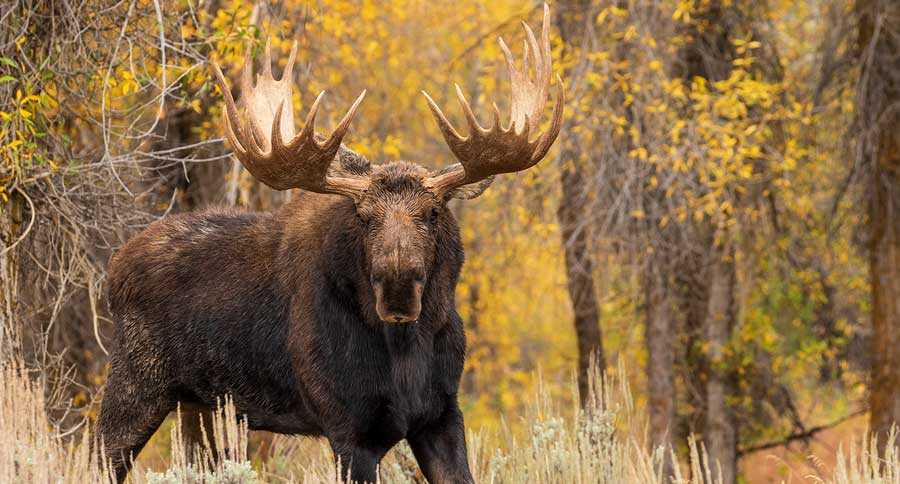
An adult Alaskan moose is about 7 to 8 feet tall at the shoulders, and easily 10 feet when you add in their heads and antlers. Even the Shiras moose, the smallest of the subspecies, is 6 feet tall at the shoulder. Again, as with weight, bull moose are typically taller than female moose.
Just to give you an idea of how big 7 feet tall is, just imagine squaring up with something as tall as Andre the Giant or Shaquille O'Neil. If you're looking at a giant bull moose with its head held high at around 10 feet, it's about the height of a basketball hoop, or two average refrigerators stacked on top of each other. Both bull moose and female moose have incredibly long legs, helping them tower over fellow cervids around the globe.
Moose Length
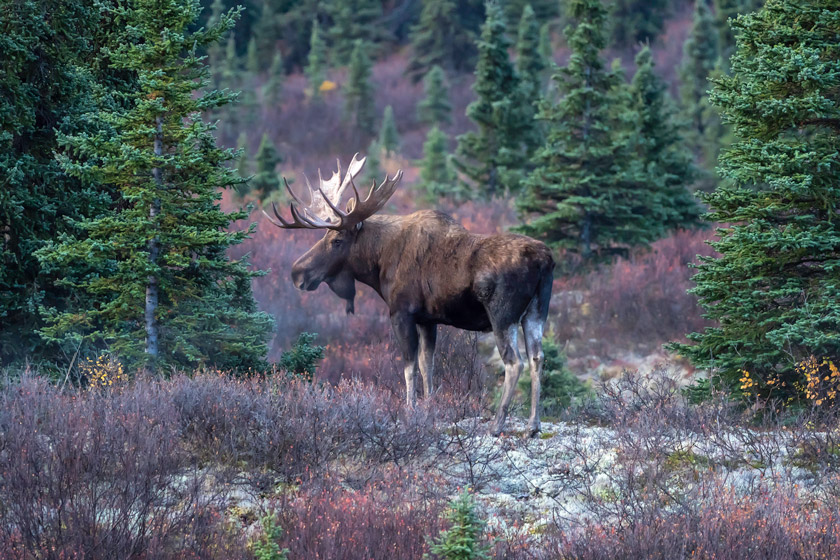
Getty: Dee Carpenter Photography
As heavy and tall as moose are, they're just as impressive in length. The average adult moose boasts a total length from head to tail of 9 to 10 feet, depending on the subspecies. Basically, they're as tall as they are long. Perhaps that's what makes a moose seem so majestic is the fullness of their bodies that perfectly complements the silhouette, but regardless, that's one big box walking through the woods.
How big is a full-sized moose?
While it depends on the subspecies, most full-sized bull moose are between 6 and 7 feet tall, and 8 to 10 feet long. Bull moose weigh between 1,000 and 1,600 pounds, while cow moose weigh between 800 and 1,300 pounds.
The largest moose ever recorded was a monstrous animal, taken with a rifle in the Yukon, Canada by Debra Card in 1999. The moose weighed over 1,800 pounds and had 19 points on one antler and 20 on the other antler.
With an animal this large, no matter the subspecies, if you're thinking of going American moose hunting, you need to remember a few things. First, don't make the mistake of going with an inferior rifle. Anything below that .30-caliber threshold is probably a no-go for a giant bull moose, and if you're smart, you'll pack as heavy of a punch as your shoulder can handle. Second, you should always maintain respect for the size and ability of moose. Moose can be territorial, especially if they are food-stressed or in the mating season, known as the rut. While people are generally concerned about predators like grizzly bears and wolves in the backcountry, moose actually injure more people than bears or wolves each year.
And, finally, have a plan for packing that big boy out should the stars align and you bag a moose.
